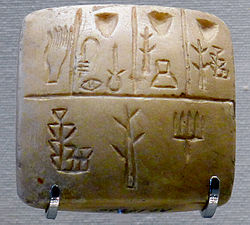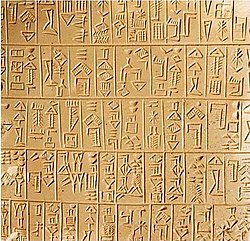Cuneiform

Cuneiform script is one of the earliest known systems of writing.[1] It used wedge-shaped marks on clay tablets, made by a reed stylus. The name cuneiform itself means "wedge shaped", from the Latin cuneus "wedge" and forma "shape". It came into English usage probably from the Old French cunéiforme.
It was first used in Sumer in the late 4th millennium BC (the 'Uruk IV' period). Cuneiform writing began as a system of pictographs. In the third millennium, the signs became simplified and more abstract. Fewer characters were used, from about 1,000 in the early Bronze Age to about 400 in late Bronze Age (Hittite cuneiform). The system used a combination of phonetic, consonantal alphabetic (no vowels) and syllabic signs.[2]
The original Sumerian script was adapted for the writing of the Akkadian, Eblaite, Elamite, Hittite, Luwian, Hattic, Hurrian, and Urartian languages, and it inspired the Ugaritic and Old Persian alphabets. Cuneiform writing was gradually replaced by the Phoenician alphabet during the Neo-Assyrian Empire. By the 2nd century BC, the script was extinct. All knowledge of how to read it was lost until it began to be deciphered in the 19th century.
Cuneiform Media
A tablet with proto-cuneiform pictographic characters, end of 4th millennium BC, Uruk III. This is thought to be a list of slaves' names, the hand in the upper left corner representing the owner.
Early pictographic signs in archaic cuneiform, used vertically before Template:Cx.
A contract for the sale of a field and a house, in the wedge-shaped cuneiform adapted for clay tablets, Shuruppak, c. 2600 BC
An extract from the Cyrus Cylinder (lines 15–21), giving the genealogy of Cyrus the Great and an account of his capture of Babylon in 539 BC
The cuneiform sign "EN", for "Lord" or "Master": the evolution from the pictograph of a throne Template:Cx, followed by simplification and rotation down to Template:Cx.
Cuneiform writing in Ur, southern Iraq
A map showing the locations of all known provenanced cuneiform inscriptions. Cuneiform Inscriptions Geographical Site Index v1.5, November 2022, from Uppsala University.
References
- ↑ Egyptian hieroglyphs also have a claim, and it is unsettled which system began first. Visible Language. Inventions of Writing in the Ancient Middle East and Beyond Archived 2021-08-26 at the Wayback Machine, Oriental Institute Museum Publications, 32, Chicago: University of Chicago, p. 13, ISBN 978-1-885923-76-9
- ↑ Lo, Lawrence (2007). "Sumerian". Retrieved June 5, 2009.








